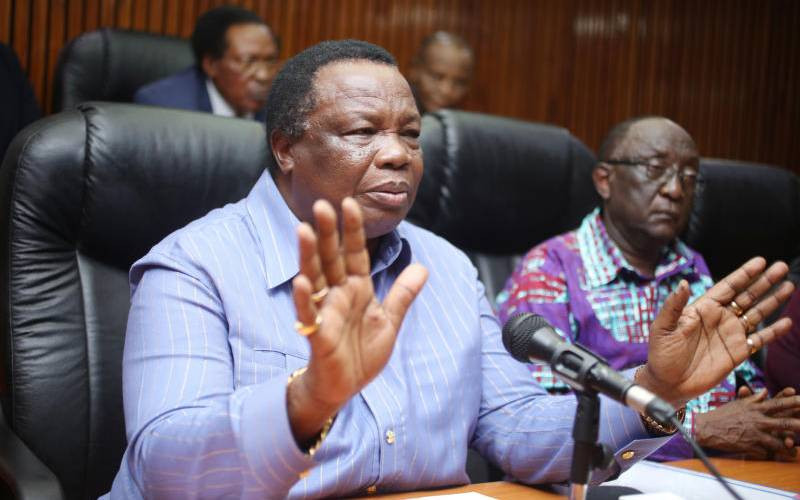Trade unions play a huge role in workers' education and governance
By Bruno Otiato | 1d ago

COTU Secretary General Francis Atwoli during a press briefing where they engaged employers to respect the rights of workers who are in trade unions
on June 21, 2023. [Wilberforce Okwiri, Standard]
In the dynamic landscape of the contemporary workforce, the pivotal role of workers’ education programmes cannot be overstated.
As we navigate the challenges brought forth by digitalisation, remote work, and the gig economy, it becomes imperative to establish robust governance practices and innovative structures in labour infrastructures.
First, the ongoing digital transformation has redefined traditional work settings through platformisation, presenting both opportunities and challenges. Consequently, the governance of Trade Union Education requires a thorough review to align with evolving international labour standards. In the UN’s Decade of Action, various factors like digital transformation, remote work, skills development, and climate change reshaped the world of work.
Workers, recognising the need for continuous learning, engage in skilling, reskilling and upskilling as their roles rapidly evolve. This prompts trade unions, education institutions, governments, and international bodies like the ILO to adopt innovative governance practices in labor infrastructures for responsive workers’ education programmes.
Key governance practices and innovations include online and blended learning, micro-credentials, competency-based learning, AI and learning analytics, teacher professional development, and technical and vocational education and training. When considering governance practices and innovations for workers’ education programmes, it is crucial to distinguish between the structure and curriculum of the programmes.
However, while discussing best practices in governance and innovations needed for workers’ education programmes, it’s imperative to take note of a number of teething issues..
In the dynamic landscape of the contemporary workforce, the pivotal role of workers’ education programmes cannot be overstated.
As we navigate the challenges brought forth by digitalisation, remote work, and the gig economy, it becomes imperative to establish robust governance practices and innovative structures in labour infrastructures.
First, the ongoing digital transformation has redefined traditional work settings through platformisation, presenting both opportunities and challenges. Consequently, the governance of Trade Union Education requires a thorough review to align with evolving international labour standards. In the UN’s Decade of Action, various factors like digital transformation, remote work, skills development, and climate change reshaped the world of work.
Workers, recognising the need for continuous learning, engage in skilling, reskilling and upskilling as their roles rapidly evolve. This prompts trade unions, education institutions, governments, and international bodies like the ILO to adopt innovative governance practices in labor infrastructures for responsive workers’ education programmes.
Key governance practices and innovations include online and blended learning, micro-credentials, competency-based learning, AI and learning analytics, teacher professional development, and technical and vocational education and training. When considering governance practices and innovations for workers’ education programmes, it is crucial to distinguish between the structure and curriculum of the programmes.
However, while discussing best practices in governance and innovations needed for workers’ education programmes, it’s imperative to take note of a number of teething issues..
Trade unions back Atwoli's move to work with President Ruto
First, we need to understand what is under review is mostly the structure of the programmes and not the curriculum.
Second, at the core of best governance practices and innovation for the worker’s education programme should be the promotion of equality, equity, and quality. Arguably, the most needed change in the curriculum is to encourage workers think creatively and independently.
Third, in adopting any governance practices for workers’ education, we must focus on the philosophy behind the governance practice to be adopted and not the practice of the same.
Finally, and like it’s increasingly being done by many schooling systems, in adopting any governance practice for workers’ education, we must understand that no two brains are the same.
The mode of teaching cannot remain the same for all workers considering different brains acquire information and knowledge differently. This explains the quote by Albert Einstein that “Everybody is a genius, but if you judge a fish by its ability to climb a tree, it will live its whole life believing that it is stupid.”
Be that as it may, benchmarks for sound and responsive workers’ education programmes must include, among others, trade union involvement, collaboration with ILO-ACTRAV, flexible curriculum design, tripartite partnerships, digital learning platforms, lifelong learning accounts, labour market analysis, social safety nets, career guidance, worker-centric policies and global learning experiences.
Trade unions play a fundamental role in workers’ education, with direct involvement through the establishment of workers’ colleges and education departments. Examples like the Tom Mboya Labour College in Kenya and the Nigeria Labour Congress showcase successful models. Collaboration between unions and ILO-ACTRAV is crucial, ensuring programmes align with workers’ needs and trade unions’ priorities. In Denmark, the tripartite consultation model fosters collaboration among government, employers, and workers’ representatives, resulting in highly skilled and adaptable workers.
Flexible curriculum design allows trade unions to adapt to changing industry requirements, while digital learning platforms offer accessible and scalable learning opportunities. Personal learning accounts empower workers to invest in their education.
First, we need to understand what is under review is mostly the structure of the programmes and not the curriculum.
Second, at the core of best governance practices and innovation for the worker’s education programme should be the promotion of equality, equity, and quality. Arguably, the most needed change in the curriculum is to encourage workers think creatively and independently.
Third, in adopting any governance practices for workers’ education, we must focus on the philosophy behind the governance practice to be adopted and not the practice of the same.
Finally, and like it’s increasingly being done by many schooling systems, in adopting any governance practice for workers’ education, we must understand that no two brains are the same.
The mode of teaching cannot remain the same for all workers considering different brains acquire information and knowledge differently. This explains the quote by Albert Einstein that “Everybody is a genius, but if you judge a fish by its ability to climb a tree, it will live its whole life believing that it is stupid.”
Be that as it may, benchmarks for sound and responsive workers’ education programmes must include, among others, trade union involvement, collaboration with ILO-ACTRAV, flexible curriculum design, tripartite partnerships, digital learning platforms, lifelong learning accounts, labour market analysis, social safety nets, career guidance, worker-centric policies and global learning experiences.
Trade unions play a fundamental role in workers’ education, with direct involvement through the establishment of workers’ colleges and education departments. Examples like the Tom Mboya Labour College in Kenya and the Nigeria Labour Congress showcase successful models. Collaboration between unions and ILO-ACTRAV is crucial, ensuring programmes align with workers’ needs and trade unions’ priorities. In Denmark, the tripartite consultation model fosters collaboration among government, employers, and workers’ representatives, resulting in highly skilled and adaptable workers.
Flexible curriculum design allows trade unions to adapt to changing industry requirements, while digital learning platforms offer accessible and scalable learning opportunities. Personal learning accounts empower workers to invest in their education.



No comments:
Post a Comment